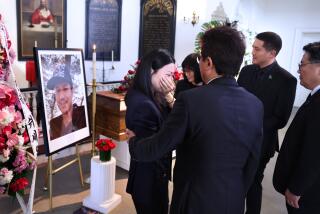Allaway ‘Recovery’ Draws Skepticism
- Share via
Mass murderer Edward Charles Allaway says he has recovered completely from schizophrenia and is ready to live a normal life. If so, mental health experts say, he is a rare exception. The vast majority of schizophrenics endure the condition throughout their lives.
Schizophrenia is a mental illness marked by a withdrawal from reality, illogical patterns of thinking and delusions. It has no known cause and no known cure--and in extreme cases has provoked sufferers to sudden deadly violence.
Of the more than 2 million Americans who have been diagnosed with schizophrenia, 10% to 20% eventually show some signs of recovery. The other 80% to 90%, according to experts, see their condition either worsen or stabilize.
As an Orange County Superior Court judge considers arguments this week that Allaway, 62, has overcome the paranoid schizophrenia that led him to murder seven people at the Cal State Fullerton library 25 years ago, experts in mental illness say the type of natural recovery Allaway describes is rare.
Even less common, they say, are those cases in which patients have overcome the disease without the use of drugs, as Allaway claims to have done. Even with the most promising patient recoveries, the odds of experiencing a relapse increase steadily with age unless patients receive regular treatment with antipsychotic drugs and psychotherapy.
Past incidents of violent behavior are viewed by some experts as another warning flag.
“The best predictor for violence is a past history of violent behavior,” said Jeffrey A. Lieberman, a professor and chairman of psychiatry at the University of North Carolina at Chapel Hill.
Schizophrenia is a broad term for disorders with symptoms ranging from deep depression to hallucinations. Sufferers may also believe they are being persecuted or conspired against. No one knows what causes schizophrenia, but some scientists believe it’s genetically inherited because it seems to run in families.
They theorize that microscopic and chemical defects in the brain’s emotion-regulating centers are possibly to blame. These defects may excessively stimulate the brain and generate false and misleading signals. Although there is no cure, medical research has developed drugs to control some of the symptoms.
In Allaway’s case, the janitor testified that before the shooting, he believed homosexual men were using the school’s library for sexual liaisons and were plotting to kill him. Soon after the shooting, officials diagnosed him as schizophrenic.
In 1977, a judge found Allaway not guilty by reason of insanity.
John Hinckley, who shot President Reagan, and Theodore Kaczynski, the Unabomber, are two well-known schizophrenics who acted out violently and have done much to forge the image of schizophrenics as prone to violence. While some experts say there is some truth to this, others say that schizophrenics more commonly pose a risk to themselves.
About half of schizophrenics attempt suicide, said Dilip Jeste, an expert on schizophrenia and the chief of the division of geriatric psychiatry at UC San Diego. The suicide rate for schizophrenics is 10%, according to the Journal of Psychiatry; the rate is 0.01% in the general population.
Experts say little is known about schizophrenics who recover without the aid of drugs because it is standard procedure now to treat schizophrenia with antipsychotic medications.
“Today, if somebody is diagnosed as having schizophrenia, it would be almost unethical not to treat him with antipsychotic drugs,” Jeste said.
Another expert, Stephen Marder, director of the VA Mental Illness Research, Education and Clinical Center of Southern California, said that patients helped by medications often relapse when they stop taking them.
“For most people, it’s a chronic condition that can be managed,” Marder said. “Of those people who go into remission and then stop taking drugs, 80% or more will relapse.”
Medical experts who examined Allaway over a period of years and testified on his behalf at recent sanity hearings agree that schizophrenic remission is rare. But they insist Allaway stopped showing signs of the disease around 1983, seven years after the shooting, suggesting that he has recovered.
But experts for the Orange County district attorney’s office, which opposes Allaway’s release, said there is no guarantee he won’t have a relapse.
Speaking publicly for the first time about the seven people he killed, Allaway testified last week that delusions led him to believe he was one of the victims of the 1976 shooting rampage--not the killer.
The former Marine and Detroit auto worker has spent nearly a quarter of a century in state mental hospitals. He has twice lost bids for freedom, but this time doctors and staff at the hospital where Allaway lives say they consider him safe for release.
More to Read
Sign up for Essential California
The most important California stories and recommendations in your inbox every morning.
You may occasionally receive promotional content from the Los Angeles Times.














